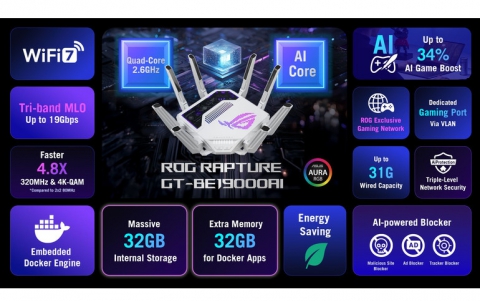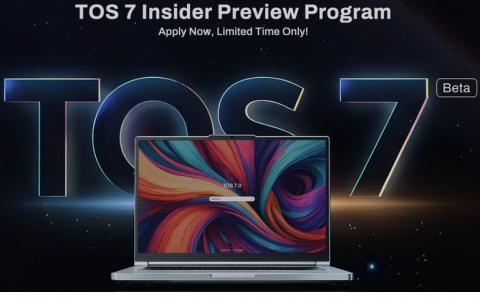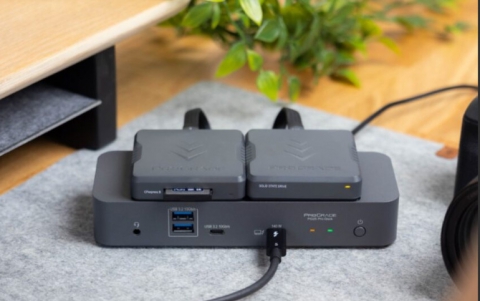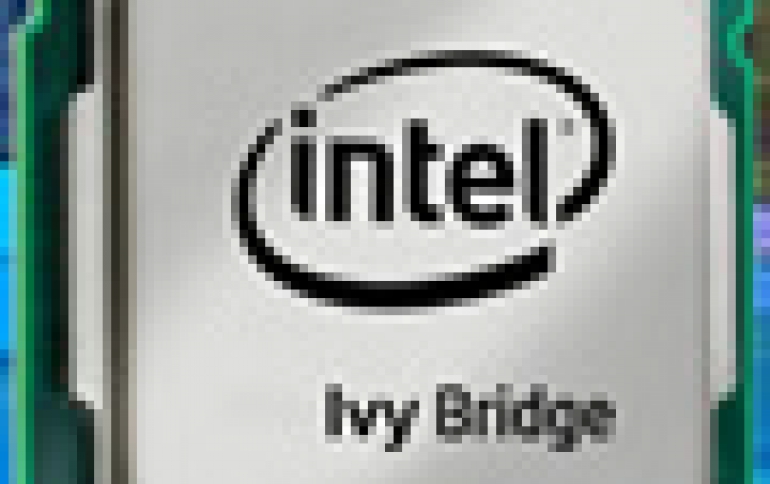
Intel Provides Overview Of Ivy Bridge And Intel 7 Series Express Chipset at CeBIT 2012
Intel gave a brief presentation of teh Ivy Bridge pltform
at CeBIT. The platform includes the Intel 7 series
Express chipset, which will also compatible with the
currently available Sandy Bridge CPUs and will integrate
USB 3.0.
As it has been widely reported, Ivy Bridge will be
Intel's first 22nm processor family due to be released in
H1 2012. According to Intel, the successor to the Sandy
Bridge design boast significant improvements in on-board
graphics, overall performance and a handful of advances
in power management and security.
Intel has spent effort to create the die of the Ivy Bridge chip modular, in order to easy create different flavors of it. The chip's largest die includes four x86 cores and a large graphics block. It can be chopped using automated generation tools to create versions with two cores or a smaller graphics block.
The company plans to release at least four major variants of the chip which packs 1.4 billion transistors into 160-mm-square in its largest version.
The first Ivy Bridge chip targets a range of desktop, notebook, embedded, and single-socket server systems with up to 8 Mbytes cache. It also integrates a memory controller and graphics, now upgraded to support DDR3L DRAMs and Microsoft DirectX 11.0 graphics APIs. The processor also packs 20 channels of PCI Express Gen 3 interconnect and a Displayport controller. The Displayport block supports three simultaneous displays including one 1.6 GHz and two 2.7 GHz links with four lanes each. Ivy Bridge is Intel's first client chip to support low power 1.35V DDR3L and DDR power gating in standby mode. It handles up to 1,600 MTransfers/s as well as 1.5V DDR3.

Other features of the built-in visuals available on the new processors include faster transcoding HD to HD through Intel Quick Sync Video, improved 3D graphics performance powered by the InTru 3D technology, clear visuals with the Intel Clear VideoHD, support for Intel Wireless Display and Intel Insider for secure downloading of 1080p movies. The graphics chip also features enhances AVX with float 16.
 In the description at CeBIT 2012, Intel made it clear
that the Ivy Bridge processors for desktops will be
backwards compatible with currently available Intel 6
series Express chipsets (Z and H series) through a BIOS
update and also that the existing Sandy Bridge CPUs will
work with the new Intel series 7 Express chipset.
In the description at CeBIT 2012, Intel made it clear
that the Ivy Bridge processors for desktops will be
backwards compatible with currently available Intel 6
series Express chipsets (Z and H series) through a BIOS
update and also that the existing Sandy Bridge CPUs will
work with the new Intel series 7 Express chipset.
The Sandy processors (socket rPGA988B, BGA1023) for mobile devices will be also compatible with the Intel series 7 Express chipset.
Intel also revealed that its 3rd generation platform (Ivy Bridge CPu and Panther Point chip) will support connectivity features including high-bandwidth Intel wireless, integrated USB 3.0 and Intel Thunderbolt Technology.
Other features include the Intel Identity Protection Technology, Intel RapidStart technology for fast resumes from hibernation (5-8 sec), Intel SmartConnect technology for always updated applications through the cloud and Intel SmartResponse technology for caching frequently used files in an attached SSD and enjoy faster system performance.
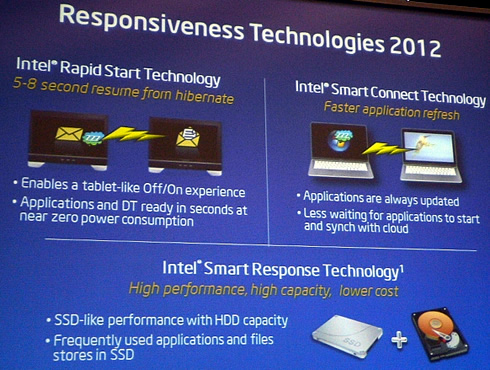
Intel also talked about the Ultrabook concept. Currently at the second generation based on the Ivy Bridge platform,Intel's "baseline" requirements for 2012's Ultrabooks include devices that will be security-ready (Intel Anto-theft and Identify Protection technologies through BIOS update), will have more than 5 hours battery life and will start up in less than 7 seconds. Limitatons also apply to the physical dimensions of 2012's ultrabooks, with a 21mm max thickness for systems with displays bigger than 14 inches and a 18mm max thickness for systems with displays smaller that 14 inches. Intel's recommended specs are even stricter, with mandatory security features built in and more than 8 hours battery life required.

Intel has spent effort to create the die of the Ivy Bridge chip modular, in order to easy create different flavors of it. The chip's largest die includes four x86 cores and a large graphics block. It can be chopped using automated generation tools to create versions with two cores or a smaller graphics block.
The company plans to release at least four major variants of the chip which packs 1.4 billion transistors into 160-mm-square in its largest version.
The first Ivy Bridge chip targets a range of desktop, notebook, embedded, and single-socket server systems with up to 8 Mbytes cache. It also integrates a memory controller and graphics, now upgraded to support DDR3L DRAMs and Microsoft DirectX 11.0 graphics APIs. The processor also packs 20 channels of PCI Express Gen 3 interconnect and a Displayport controller. The Displayport block supports three simultaneous displays including one 1.6 GHz and two 2.7 GHz links with four lanes each. Ivy Bridge is Intel's first client chip to support low power 1.35V DDR3L and DDR power gating in standby mode. It handles up to 1,600 MTransfers/s as well as 1.5V DDR3.

Other features of the built-in visuals available on the new processors include faster transcoding HD to HD through Intel Quick Sync Video, improved 3D graphics performance powered by the InTru 3D technology, clear visuals with the Intel Clear VideoHD, support for Intel Wireless Display and Intel Insider for secure downloading of 1080p movies. The graphics chip also features enhances AVX with float 16.
 In the description at CeBIT 2012, Intel made it clear
that the Ivy Bridge processors for desktops will be
backwards compatible with currently available Intel 6
series Express chipsets (Z and H series) through a BIOS
update and also that the existing Sandy Bridge CPUs will
work with the new Intel series 7 Express chipset.
In the description at CeBIT 2012, Intel made it clear
that the Ivy Bridge processors for desktops will be
backwards compatible with currently available Intel 6
series Express chipsets (Z and H series) through a BIOS
update and also that the existing Sandy Bridge CPUs will
work with the new Intel series 7 Express chipset.
The Sandy processors (socket rPGA988B, BGA1023) for mobile devices will be also compatible with the Intel series 7 Express chipset.
Intel also revealed that its 3rd generation platform (Ivy Bridge CPu and Panther Point chip) will support connectivity features including high-bandwidth Intel wireless, integrated USB 3.0 and Intel Thunderbolt Technology.
Other features include the Intel Identity Protection Technology, Intel RapidStart technology for fast resumes from hibernation (5-8 sec), Intel SmartConnect technology for always updated applications through the cloud and Intel SmartResponse technology for caching frequently used files in an attached SSD and enjoy faster system performance.

Intel also talked about the Ultrabook concept. Currently at the second generation based on the Ivy Bridge platform,Intel's "baseline" requirements for 2012's Ultrabooks include devices that will be security-ready (Intel Anto-theft and Identify Protection technologies through BIOS update), will have more than 5 hours battery life and will start up in less than 7 seconds. Limitatons also apply to the physical dimensions of 2012's ultrabooks, with a 21mm max thickness for systems with displays bigger than 14 inches and a 18mm max thickness for systems with displays smaller that 14 inches. Intel's recommended specs are even stricter, with mandatory security features built in and more than 8 hours battery life required.










